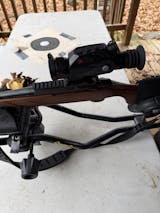
Top 20 Thermal Optic Q&A
Share
Top 20 Thermal Optic Q&A
1. What is thermal optics?
Thermal optics use infrared radiation to detect heat signatures, allowing users to see in low-visibility conditions by capturing temperature differences rather than light.
2. How does thermal imaging work?
Thermal optics detect infrared radiation (heat) emitted by objects and convert it into an image, showing warmer objects as lighter shades and cooler objects as darker shades.
3. What is the difference between thermal imaging and night vision?
Thermal imaging detects heat signatures and can operate in complete darkness, while night vision amplifies ambient light, making it less effective in pitch-black conditions.
4. Can thermal optics see through walls?
No, thermal optics cannot see through walls as walls block infrared radiation. However, they can detect heat on surfaces or see heat signatures through certain obstructions like smoke or fog.
5. What are the primary uses of thermal optics?
Thermal optics are used in security, surveillance, hunting, wildlife observation, firefighting, search and rescue, and industrial inspections.
6. What is the range of a typical thermal optic?
The effective range depends on the model, but consumer thermal optics can detect objects up to several hundred yards, while professional-grade units may reach over a mile.
7. Are thermal optics affected by weather conditions?
While rain, fog, and humidity can slightly reduce performance, thermal imaging generally works well in most weather conditions.
8. Can thermal optics detect camouflaged objects?
Yes, thermal optics can often detect camouflaged objects because they rely on heat signatures rather than visual appearance.
9. Do thermal optics require batteries?
Yes, most thermal devices run on batteries, which provide power for image processing and display.
10. How long do thermal optics batteries last?
Battery life varies by model and usage but typically lasts between 4-10 hours on a full charge. Some models offer extended battery packs or external power options.
11. Are thermal optics safe for the eyes?
Yes, thermal optics are safe for the eyes, as they do not emit harmful radiation and only capture infrared light.
12. What is the difference between uncooled and cooled thermal optics?
Uncooled thermal optics are common and operate at ambient temperature, while cooled optics use cryogenic cooling, enhancing sensitivity but at a much higher cost.
13. Can thermal optics record images or videos?
Many modern thermal devices offer recording features, allowing users to capture images or video of what they observe.
14. How do I focus a thermal optic?
Some thermal optics have manual focus options, while others use fixed focus or autofocus, especially at longer ranges.
15. Are there different color palettes in thermal imaging?
Yes, thermal devices often offer color palette options, like white-hot, black-hot, and rainbow, each enhancing different heat contrasts for various applications.
16. What is the difference between refresh rate and frame rate in thermal optics?
Refresh Rate: This is how often the sensor updates the thermal image per second. A higher refresh rate, measured in Hertz (Hz), like 30 Hz or 60 Hz, provides smoother, more fluid imaging, especially for moving objects.
Frame Rate: This refers to the rate at which images (or frames) are displayed on the device’s screen per second. While often matched with the refresh rate, the frame rate might be lower than the refresh rate on some devices, affecting how smooth the image appears.
17. Can thermal optics be used in the daytime?
Yes, thermal optics work regardless of lighting, so they are effective both day and night.
18. How should thermal optics be maintained?
Keep lenses clean, avoid extreme temperatures, store in a protective case, and replace batteries as needed. Refer to the user manual for specific care instructions.
19. What is the average lifespan of a thermal optic?
With proper care, most thermal optics last between 5-15 years. Professional-grade models may last longer due to more durable components.
20. How much do thermal optics cost?
Prices vary widely, from a few hundred dollars for entry-level models to several thousand for high-end or professional units, depending on features and performance capabilities.
These questions cover foundational information and will address typical customer concerns about thermal optics!





